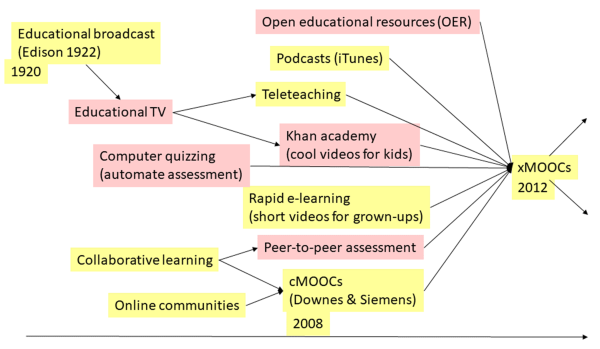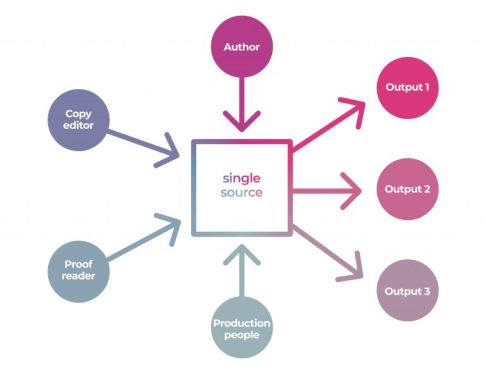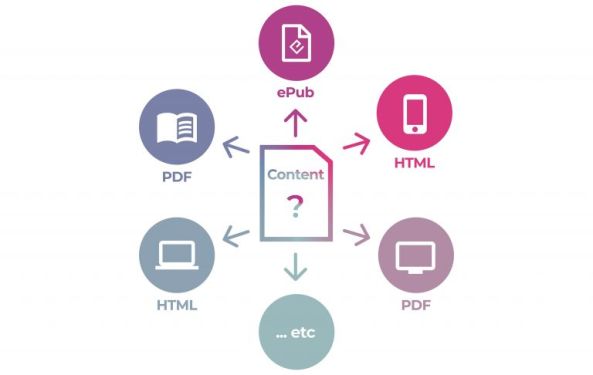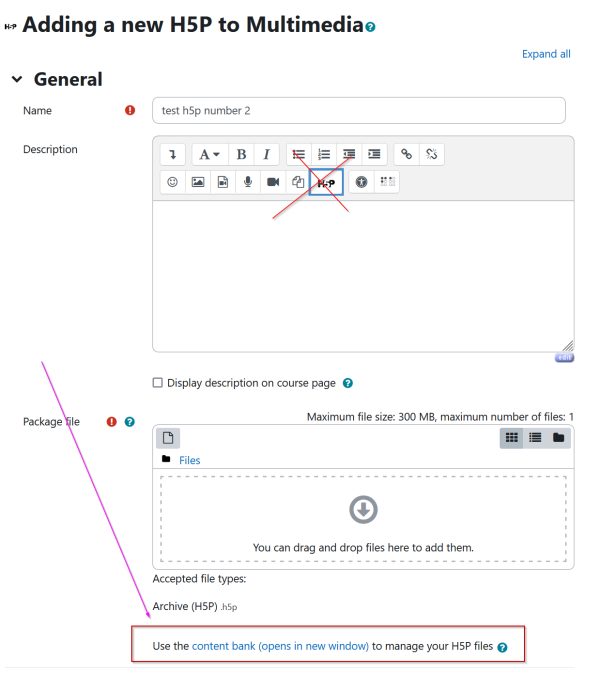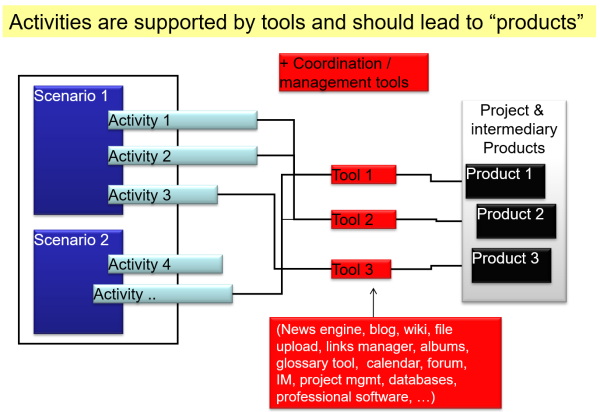Program design and implementation (CAS HEiE) - week 3
Week 3 - Learning materials and technical Infrastructure
- Interactive Class: Monday, March 27: 18h00 - 20h15
- Interactive Class: Wednesday, March 29: 18h00 - 20h15 (Guest presentation par Beekee)
- Public tutoring session: Saturday, April 1: 18h00 - 20h00
Learning goals
After discussing competencies (learning goals) and some assessment and certification methods in weeks 1 and 2 we will now look at contents and interactive environments.
- Recall types of technology (EdTech in general, environments, courseware, ...)
- Create online content, include some interactive materials
- Use online virtual environments
- Select educational technology
- Recall basic principles of teaching and learning
- Evaluate sustainability
- Plan for autonomy
Week 1 grading
- Alice: section missing
- Most: hw2 was not submitted. Forum interaction could be improved.
Week 2 homework
- Only two submissions.
Questions
- .....
Wednesday preparation
- Please install eXe: https://exelearning.net/en/downloads/
Educational Technology Overview
Educational technology is concerned with the use of technology in order to improve education. Alternative names:
- Instructional technology
- Educational communications and technology
- Learning technology
- Technology-enhanced learning
- Digital learning
- Media didactics
- EdTech
- E-learning
Use of different words for educational technology sometimes reflect different social, cultural or pedagogic stance.
Educational technology is a field, educational technologies refer to various technologies used in education and learning, e-learning (or its modern "digital learning" equivalent) is often used as an umbrella term for using technology in online, blended, workplace or classroom learning.
All of online, classroom, workplace and informal learning can use educational technologies
Functions of a learning environment
A learning environment is a system that can be defined in terms of a set of functions that must be present.

- Each function is implemented with structures and roles. Some or all of them can be supported by technology.
- A good learning environment can have almost no technology or a lot of technology.
- Also, good technology can be very simple (paper, walls, Lego bricks, text-based virtual reality ....)
Schulmeister (2005) [2] distinguishes e-learning environments of type A (learning material driven) and type B (communication driven). The former represents for example traditional distance teaching, the latter small online classes.
Summary: Educational technology is technology-enhanced learning in many forms.
Types of digital learning tools
|
Category |
Description and examples |
|---|---|
|
Presentation |
Presentation and organization of contents (texts, pictures, diagrams, multimedia animations) on various technical supports. |
|
(Extra) Information |
The computer as a library including on-line encyclopedias, content repositories, etc. |
|
Interactivity with a media |
Various kinds of interactions that include quizzing software, CBT, Simulations, microworlds, etc. |
|
Communication. |
Various computer-mediated communication (CMC) tools such as email, forums, chat, audio/video conferences, virtual environments, etc. |
|
Professional software tools |
E.g. word processors, CAD systems, simulation software, laboratory software, etc. |
|
Cognitive tools |
Cognitive tools are a combination of professional software tools, information, interaction (and more recently) communication and social software. |
The Great Media Debate
- Media are mere vehicles that deliver instruction but do not influence student achievement any more than the truck that delivers our groceries causes changes in our nutrition. (Clark, 1983) [3]
- However, one can argue that different media do have different affordances: attributes of media do influence learning gains, but these attributes must be explained in terms of more general variables. e.g., the difference between an explanation in a text and in a video could be a demonstration effect.
Discussion: How much difference does a media make ?
EdTech use as a function of learning type
Use of educational technology is often tied to the type of learning and its associated pedagogic strategies:
|
Learning I-II-III |
Major learning content types |
Example designs that can use technology |
Favored families of technologies |
|---|---|---|---|
|
I: know that |
I-a Facts : recall, description, identification, etc. |
· direct instruction · programed instruction · mastery learning · e-instruction |
· Presentation of contents (texts, pictures, diagrams, multimedia animations) on various technical supports. · Online tests. |
|
I-b Concepts: discrimination, categorization, discussion, etc. |
· discovery learning · exploratory learning |
· The computer as a library |
|
|
II: know how |
II-a Reasoning and procedures: inferences, deductions, etc. + procedure application |
· simulation, · virtual laboratory |
· Various kinds of interaction that include quizzing software, CBT, Simulations, microworlds etc. |
|
II-b Problem solving and production strategies: identification of sub goals + application of heuristics/methods |
· case-based learning · inquiry-based learning · problem-based learning |
· Various computer-mediated communication (CMC) tools such as email, forums, audio/video conferences, virtual environments, social software, etc. |
|
|
III: knowing in action |
III Situated action: action strategies in complex and authentic situations |
· project-oriented learning |
· Social software, portalware, word processors, CAD systems, simulation software, laboratory software, etc. |
|
IV: Other |
IV Other: e.g. motivation, emotion, reflection, i.e. elements that could intervene in all the other categories |
· ARCS, · learning portfolios |
· Tools that favor presence and reflection. |
Selection of technologies depends on many factors. The most important ones are
- Type of learning and to a lesser degree type of subject area
- Type of pedagogy
- Contextual constraints (digital literacy of participants, access to infrastructure ....)
In any case, first principles of instructions do apply:
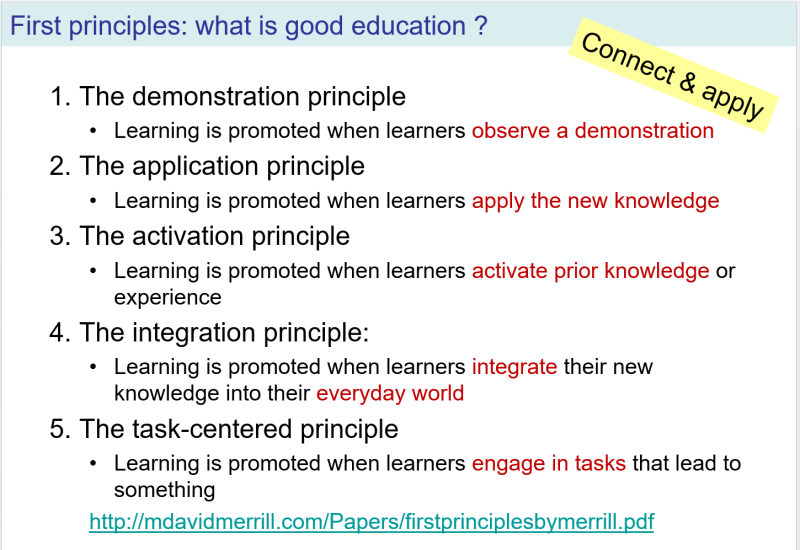
Hype Cycles
Educational Technology (in short: EdTech) is fairly dynamic and somewhat unstable. Outside of the field of research, use of technologies in education is often technology hype driven, a process that leads to mixed results. About every 15 years, new players enter the field and push new technology without understanding prior experience ....
(Martin Weller, 2019 [7]
Example hype curve (2016). Official Gartner versions are under copyright and difficult to "find".
Most technology initiatives fail, or need several restarts. Most often, new actors are not aware of prior experience.
Often, it takes many years for an idea to become implemented and accepted, e.g., Edison invented MOOCs over a century ago.
Summary: When a new technology is being pushed, try to find its 10-20-year-old predecessor and learn from its well-documented literature.
Digital literacy
Digital literacy for teachers
- TPACK: Make sure that participants (in particular teachers) master technology and can combine tech with pedagogy and subject knowledge and the three together.
- TPACK = Content (CK), Pedagogy (PK), and Technology (TK).
- Intersections between three primary forms: Pedagogical Content Knowledge (PCK), Technological Content Knowledge (TCK), Technological Pedagogical Knowledge (TPK), and Technological Pedagogical Content Knowledge (TPACK).
- conteXtual knowledge (XK): the organizational and situational constraints that teachers work within.
Digital Literacy for Learners
A similar reflection must be done regarding student readiness. Mastery of digital skills is not enough, students must be able to cope with different types of pedagogies and use technology for diverse learning activities and interacting with content.
E-learning competence is not part of the official competency frameworks, i.e., the ability to copy with new environments and new digital pedagogies.
Driving, integration and community tools
Technology can provide good support for managing tasks (schools, programs, classes, activities), for integrating various types of learning technology and to enhance exchange in communities.
Driving / management tools
- A central tool in other situations that traditional classroom teaching is a tool to "drive" and to "monitor" activities.
- Usually a Learning Management System (LMS) like Moodle is used, but groupware and project management software also work.
- Often, teachers just use email or instant messaging. While those types of tools work, it requires an extra effort since messages can be lost and individual items have to be collected manually. Therefore, not recommended.
Integration Tools
Integration tools pull a number of other tools together. The most popular ones are Learning management systems (LMS). You can use other systems. e.g., for communal constructivism, a wiki may be a better solution. In that case, only use the LMS for grading.
The table below shows some alternatives. Some of these have limited integration functionality.
|
Type |
Example systems |
|---|---|
|
Activity-based e-learning systems |
LAMS, Graasp |
|
Campus software (Extra/Intranets) |
uPortal |
|
Conferencing software |
Saba, Adobe Connect, Teams, Zoom |
|
Content management systems and community portals |
Wordpress, Joomla, Drupal, .... |
|
CSCL Scripts |
(FROG) |
|
E-learning platforms (LMS) |
Moodle, Canvas (dozens of others) |
|
E-Porfolios |
Mahara |
|
Groupware |
e-mail and forums, BSCW, Teams, .... |
|
Hypertext systems (specialized) |
StorySpace, Construit! |
|
Hypertexts (read/write) |
MediaWiki |
|
Knowledge construction environments |
CSILE, Knowledge Forum (see also wikis) |
|
MOOC systems |
Coursera, EdX |
|
Repositories |
Merlot, MIT Open courseware, OpenStax, EdModo |
|
Virtual environments |
MOOs and MUDS, 2D Environments like Gather Town, Active Worlds, Second Life, Adventure Academy |
|
Social and personal environments |
Weblogs, ELGG, Netvibes |
|
Web 2.0 services , social networks, link sharing, micro-blogging |
FlickR, YouTube, Facebook, Twitter, Mixxt, Tumblr, Mendeley, CiteSeer, CiteULike, Diigo |
Personal Learning Environments
High performance students tend to create their own virtual environment that integrates various tools and links. PLE software was very much hyped in the early 2000s, but most of these systems are dead now. That means that learners should be encouraged to create their own system from a combination of standard tools.
Simple solutions:
- Links in a desktop (or mobile phone) folder
- Webtops, for example Netvibes ( https://www.netvibes.com/danielkschneider, I do not use this...)
- Bookmark bar in the navigator.
Productivity environments:
Such systems can be installed with a few clicks from a good hosting provider.
Community tools
Learning Management systems are bad community tools, for several reasons:
- Communication channels are rather formal
- Access to tools and contents is restricted to a given class
- The "fun" part is missing
We therefore suggest creating at least a channel on an appropriate instance messaging service:
- WhatsApp, Telegram or Signal for regions without much Internet
- Slack (fee required for larger volumes), Mattermost (free), etc.
2D virtual environments are appropriate to organize community events that work in most settings, since they are low bandwidth, contain presentation tools, audio/video on demand and work in browsers.
- Gather town - Demo (see link URL in UNIGE Moodle, or in the chat)
- Alternatives: Topia - https://topia.io/unconference Topia unconference
- Soccoco, and more ......
In addition, it can be useful to organize some sessions in a "3D virtual world", usually require the installation of large software.
- Active Worlds (3D, OK for low band width and low-end computers, works since 1998) (Demo on demand). Popular for language teaching.
- Second Life (3d) (Demo on demand)
- Metaverse (3D immersive, in the future)
Etherpads also can have some icebreaker functionality, but their main purpose is brainstorming and creating draft documents quickly.
- One could ask participants of a class to present themselves synchronously in the first session.
- https://framapad.org/abc/en/ (free online service)
- Demo: https://mensuel.framapad.org/p/cas-heie-9xcb?lang=en
User tracking and learning analytics
- LMS and other systems allow tracking user activities
- Moodle has reports both at courses and system level
- Moodle 4 Gradebook allows tracking of assignments. The scroll-down menu provides different views.
- In addition, some learning objects can send information to so-called Learning Record Store (LRS) via the XAPI protocol.

An LRS allows tracking learning across several systems, e.g., an LMS, a simulation/serious game, a virtual environment.
Start of Wednesday lesson below
- week 1 assignments (see Moodle)
- week 2 assignments (see Moodle)
Creation of Learning Materials
- Learning materials include text, interactive and non-interactive multimedia (computer-based training, simulations, serious games), video, etc. The use of learning materials will be discussed in week 4. Here, we focus on producing learning materials.
In higher education:
- Text with illustrations dominates in higher education. It can be delivered in traditional formats (Word,PDF), somewhat interactive e-learning "packages" or screen readable e-books.
- Video presentations (e.g., MOOCs) and screen casts (e.g., software training) dominate the informal market
- Mass education makes use of quizzing software, for both self-evaluation and learner evaluation
- Simulations and serious games are somewhat popular in some science domains as well as applied social science
- Writing and other production tools are used in small class teaching
- Computer-based training modules (other than simulations) can complete text or video presentations, e.g., allow for online exercising or drill and practice.
I do not consider cognitive tools and professional tools to be learning materials in the narrow sense, but they can enhance or even replace learning materials.
- Communication and (somewhat) collaborative software are used to support learner-learner interaction like group work and learner-teacher interactions. They can be tied to learning materials, e.g., learners can be asked to annotate a text, engage in multi-user simulations and communicate, etc.
- Pencil, paper and other tangible tools are used in design-oriented classrooms, but there also exist paper-based learning tools (besides books), i.e., worksheets or worksheets that include cognitive tools like in the picture shown below.
Innovative pedagogy does not need computers !
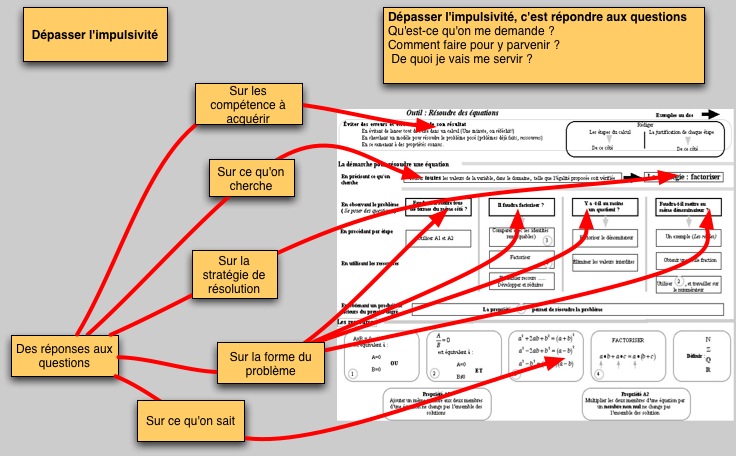
It is difficult to find good data about technology use in higher education. Some reports, e.g. How technology is shaping learning in higher education [8], do seem to filter out more obvious uses and focus on fashionable items like control and adaptation.
Single source publishing of textbook-like materials
According to Adam Hyde (2001) [9] single source publishing means:
- All participants (authors, editors, publishers) work on the same document. This reduces cost of producing and maintaining open (and commercial) contents.
- The same document can be rendered in different formats (Print PDF, EPUB, HTML, etc.). This is important since it allows diffusing text for off-line reading (on paper, mobile devices or local computers)
Output formats
- Learning materials should in principle by delivered in a variety of formats:
- Print version (usually PDF)
- Online version for computers (usually HTML)
- Hypertext version for mobile devices (usually HTML) and off-line computers
- Book version of online reading (e.g., PDF, HTML, Epub3)
- Book version for off-line reading (e.g., Epub3)
- Example: Teaching in a digital age which was published with PressBooks as described in Getting started in writing an open textbook [10].
Interactivity
- Online text books can include animated and interactive multimedia. This is increasingly used in courses that require students to manipulate data. Something they do not do enough! For example, see the Jupyter technology.
- Some online books can interact with an LMS (e.g. pass results of H5P activities to the gradebook) or a LRS
Input formats and exporting functionality
There exist several technological solutions for creating open source textbooks from a single source. None is very easy to use, i.e., authors do need to train themselves (or get help from a technical person)
- Most Word Processors allow creation of PDF and HTML. Screen readable versions (HTML and ePub) are often less than optimal. Converter software such as Calibre (free) can convert various document types to ebooks, e.g. in ePub format. Alternatively, it is possible to use so-called formatting software like Latex to create both print and online text.
- MediaWiki has a book creation extension that produces acceptable PDF. However, it seems that this extension is dying. A more complicated replacement does exist. Kiwix is a project to deliver MediaWiki pages offline, but the procedure is complicated. At this time, there is no easy and good solution.
- Systems like PressBook either require server installation skills or a fee for a service-based solution (a minimal version is free). The Pressbook directory lists nearly 5000 books as of october 2022.
Demo Calibre or Mediawiki Book or and or PressBook
Interactive Courseware / e-learning objects
Interactive courseware can be used both for individual distance learning (traditional e-learning) and classroom learning (either organized with different activities or collaborative/collective work). Creative interactive courseware is resource intensive but there exist many open source objects that you can use and sometimes tailor to your need.
Below is a table that lists a few categories of interactive courseware, plus authoring systems. Not shown in table: some require "players" to be installed locally. Others run in a web browser.
|
Type |
Example authoring systems |
|---|---|
|
Advanced CBT/WBT authoring software |
Articulate Storyline, Adobe Captivate |
|
E-content authoring tools |
eXe, Opale, Reload editor, CBT software (see above) |
|
Activity authoring tools (e.g. learning design) |
Currently, IMS LD is an almost dead standard and therefore we recommend using online tools such as LAMS |
|
Scenario design tools |
CompendiumLD, ABC LD & Learning Designer |
|
Multimedia |
HTML5, Captivate, Storyline, H5P (available in Moodle) |
|
Microworlds and simulations |
AgentSheets, SimQuest, CoolModes, PhET, Go-Lab, NetLogo, Markstrat |
|
Game development |
e-adventure, GameMaker, gaming engines like Neverwinter Nights or Unity |
|
Intelligent tutoring systems |
- |
|
Cognitive maps |
Mindmap, IHMC CmapTools, FreeMind, PIViT, VUE, Go-Lab |
Below, we will shortly look at both simple e-learning courseware and simulations
Courseware for traditional e-learning
Traditional e-learning (in particular in industrial, government and NGO context) are segmented on-line books, which may include multimedia as well as quizzing.
Such contents:
- are standardized as co-called "learning objects" (e.g., SCORM 1.3, SCORM 2004 or CMI5)
- can be authored with an advanced authoring tool like Captivate or a free tool like eXe or Opale.
- can be deployed in different LMS or sometimes off-line readers (i.e., users can escape technology lock-in)
- The most recent format (XAPI) can interact with a so-called LRS that allows for detailed user tracking and learning analytics across platforms
Example tool: eXe - Demo
- eXe download (on a Mac, you need to change permissions)
- eXe runs in a web browser of your choice. Several languages are supported.
- Guides
H5P example (in Arbores Tech Moodle)
- H5P is an initiative to create interactive multimedia widgets for a diversity of platforms.
- (If time, Demo), in Arbores Tech Wiki
There exist two ways of inserting an H5P widget. (1) Use an H5P activity that is already in Moodle's database or (2) import one, either as activity or in any random text (you can do this almost anywhere). Start by using the builtin H5P activities, using the H5P activity creator.
Simulations and serious games
Simulations and (some) serious games allow learners to learn to solve problems, testing "what if" hypothesis", immerse in role play, etc. There are two broad categories: (1) “About something” simulations that each something about an object or a principle and (2) “How to do something” simulations that teach how to perform. (Alessi & Trollop, 2001) [11]
About simulation examples
Demo Netlogo. The Netlogo multi-agent programmable modeling and dynamic simulation environment can be downloaded and played locally. Some simulations also work through a web application.
- Virus simulation. Use: First look at the
Model Infobelow, Click onsetupto accept paramers, thengoand observe.
Demo MacDonalds. This serious game makes you (quote) "discover all the dirty secrets that made us one of the biggest companies in the world." See also: Catégorie: Jeux pédagogiques (EduTechWiki)
Graasp
The Graasp light-weight activity-based learning platform includes many simulations for science teaching. You first have to choose a either a simple activity or a type of scenario structure and then you can add "labs" and "apps" to various stages.
Choosing the Right Media
Choosing the right media is an optimization question. In Emergency education, all of the SECTIONS (Bates, 2015:chapter 8.1) are important:
- Students
- Ease of use
- Cost
- Teaching functions, including pedagogical affordances of media
- Interaction
- Organizational issues
- Networking
- Security and privacy
From an activity-based, task centered educational perspective, tools must support activities and allow creation of "products".
Repositories
Repositories are online libraries that contain off-line or online learning materials and tools. There exist many systems. Some last for a fairly long time, others fade away or change web address. Others may have outdated contents. i.e., one can observe sustainability problems.
Examples of free resources:
- Merlot (includes interactive learning software, e.g. search for "simulation")
- PressBooks (collection of PressBook made e-books)
- OpenStax (courseware from Rice university)
- MIT Open Courseware (course syllabi and materials)
There are also "meta" repositories, e.g.
- OER Commons
- EdModo had 100 million users, but closed in Sept. 2022
Learning objects are also sold by major publishing companies, sometimes through learning platforms.
Technical infrastructure
We could distinguish a variety of technology for private, workplace, classroom and online teaching and learning.
- Physical passive objects - paper, pens, Post-its, board games, building blocks, etc.
- Active objects and electronic boards - e.g., educational robots, Adafruit boards, Arduino boards.
- Connected active objects - e.g., sensors
- Machinery (printer, cutter, 3D printer, laser cutter, embroidery machine, milling machine, various power tools)
- Mobile computers - tablet computers, smart phones
- Personal computers - e.g., Windows, Mac, Linux.
- Physical Servers - typically a Linux machine, but a PC/Mac also can do. Raspberry boards only cost 50 Euros and one can buy various ready-to-go boxes, e.g. Freedom Box for 70 Euros or Library box. See also Beekee from our Guest lecturer.
- Install your private Moodle, MediWiki, chat server, etc. on the local network or the Internet
- Shared Hosted servers - between 50 and 150$ per year.
- A good swiss provider is about 130CHF/year. Allows one-click installation of many platforms, including Moodle, Wordpress, Mediawiki. Also allows manual installation of PHP-based servers using standard libraries.
- Hosted servers - access your own server - starting at 20$/month
- 40CHF/month in Switzerland
- Cloud services - get your Moodle, MediaWiki, CMS, anything as service - prices depend on volume and quality.
On the software side, we can distinguish (simplified):
- Applications that run locally in a device (e.g., various Authoring tools, Data analysis tools, Word)
- Applications that run locally in a device but are network enabled (e.g., most cell phone apps, Word 365, Video Games)
- Applications that run in a web browser (e.g., extensions like screen capture, spell checker)
- Applications that run in a web browser and need an Internet connection (e.g., Google docs)
- Services that run online and communicate with a web browser or a local app. (e.g., Moodle)
How could I get my own Moodle or other web application ?
Running a local server
- Cheap solution: any old computer can do or you can buy a less than 100 Euros board.
- Requires technical skills, e.g. read this to get an idea for a Windows installation
- Backup and reliability issues
Using a shared hosting solution
- Is a comparatively cheap solution (less than buying a server)
- Depending on the hosting organization, requires only technical reading skills, i.e. be able to follow instructions.
- Moodle example instructions (unless otherwise stated no endorsement, I did not test)
- Moodle™ LMS at Infomaniak (tested and used, CHF 10.70 / month)
- How to Install Moodle: 3 Methods at Hostinger ($2.5 to 17$ / month).
- How to Install Moodle on Hosting Server? at Scalahosting ($4 to $14 / month)
Using a hosted server
- Most flexible solution, but requires technical skills
Using a platform as service
- Easiest and most reliable solution (if from a major provider)
- More expensive than using a shared hosting solution
- Moodle Example:
- Moodle cloud (by Moodle, 160 AUD/year for 50 users).
Local servers without the Internet
There exist several solutions to create local networks for remote areas, e.g., refugee camps that do not have Internet connection for everyone.
Beekee
- Beekee, a system to deliver digital learning and face-to-face interactive sessions without the internet.
- by Sergio Estupiñán, PhD, cofounder
Autonomy
Research shows that, certainly after Covid, most programs in "western" universities use technology.
- Most classes use a LMS for support, but use only minimal features, e.g., for distribution of presentation slides and documents to read. Some use assignments management, quizzes and forums.
- Prior research did show that few universities use a rich mix of technology. For example, the EU Hy-Sup [12]project developed the following taxonomy for teachers.
Taxonomy [13]
- Type 1: "Scene". Environment centered on teaching and knowledge acquisition. Content-oriented configuration. The online environment is composed principally of textual resources, which are used to support the face-to-face course.
- Type 2: "Screen". Teaching centered environment providing multimedia resources. Content-oriented configuration. The online environment is used to support the face-to-face course. The resources provided online are composed of textual and numerous multimedia resources.
- Type 3: "Cockpit". Teaching centered environment providing interaction tools. The online management tools are used to allow students to manage their learning. Several reflexive activities are also provided.
- Type 4: "Crew". Centered teaching environment tending to support learning. This model focuses on building knowledge and supporting interpersonal interaction.
- Type 5: "Metro". Open environment centered on learning. This model fosters students' freedom of choice. It provides a possibility for students to access external resources, offers mentoring, and supports interaction among students.
- Type 6: "Ecosystem". Open learning environment supported by a rich and varied environment. This model is characterized by the exploitation of a large number of technological and educational possibilities. It provides, for example, a possibility for students to choose their own learning path.
The EU self-evaluation survey is no longer online, but there is the "CARENN french version
Teacher autonomy and influence
Highly autonomous teachers use their own mix of technology
(see the "ecosystem" above)
- In most settings, teachers are ignored when an institution buys into a technology. e.g., read this blog post regarding US school districts (november 2, 2022)
- Local infrastructure often lacks flexibility or even basic service. Acquiring basic IT skills to run and use online services is key for being able to introduce certain new pedagogies. See also above: What does it take to own platforms like Moodle. The answer is some small funding plus technical reading skills.
- An increasing amount of interesting software is available online and that greatly augments teacher autonomy since they no longer have to relay on non-cooperative IT services and face locked computers. However, free online applications tend to disappear (even if they support thousands of teachers) or only work with small classes.
Learner autonomy
- Learners should be encouraged to create personal learning environments that include created works and achievements.
- Some learners turn to using variety of online information (including tutorials, MOOCs) to complement information received in school. Teacher's and the system as a whole should learn to interact with this dynamic.
- In its most radical form, there are unschooling and deschooling movements, somewhat inspired by Ivan Illi'sc Deschooling society [14].
In any case, society must find a way to "certify" informally acquired knowledge.
Sustainability and interoperability problems
Educational infrastructure and learning materials should be as sustainable as possible since (1) teachers invest a considerable amount of time creating one-line spaces plus learning material and (2) Educational content does not change very much over the years (most subjects taught in high school are over 70 years old)
- Software stops running on newer machines
- Multimedia and text formats disappear (e.g., Flash and client-side Java)
- Websites close, contents are destroyed or otherwise lost
- Contents migrate and redirections do not last
- Contents cannot be migrated from one type of platform to another
- .....
A few tips:
- For larger projects use technology that has been around for at least 10 years and that is popular for real. Good examples are MediaWikis (Wikipedia) and Moodle.
- Use standards whenever you can and insist that your institutions use standards
- Create e-portfolios (at least well-organized folders in the "cloud"), i.e., do not trust organizations to keep your contents
- Separate creation of learning materials from creation of learning activities. Learning activities (e.g., sequences in a platform may go away) but materials can stay.
User experience
Consider four factors:
- Usability
- Perceived usefulness
- Promotor score
- Pleasantness
A simple, fairly well-predictive model is the Technology Acceptance Model (TAM) [15]
Technology acceptance can be measured with a simple questionnaire.
Week 3 assignments
You will continue to work on the design of your project.
Week 3 mini project
(1) In your Program Design Form you started in week one:
- Provisionally define the global technical infrastructure required, e.g., server hosting and support model (where it is located, who is paying for it, who is maintaining it) and devices that teachers and learners must have accesses to.
- Provisionally define elements of the technical infrastructure in terms of software. Describe their function and how they support teaching and learning, including presentation of information, technology-supported learning activities follow-up (learner support), community support and evaluation.
- Shortly define the type of learning materials you plan to use in your program (you may limit description to one sample course)
(2) In your Moodle class on Arbores Tech, create one learning material. It can be provisional, i.e. you can make changes for the final project.
- Choose from one:
- Create a short but meaningful sample document with eXe, export to Scorm 1.3 and import the Scorm 1.3 package in Moodle
- Create a meaningful HP5 activity in your Moodle Class
- Create an ebook in all of EPUB, PDF and HTML formats. You can use prior materials. Make it available for download in your Moodle class.
- Create a Moodle sequence (cannot be exported).
"Deadline:" : Sunday, April 2 24h
Reporting
In the University of Geneva Moodle, submit the homework.
- provide the names of other group members please
- Provide either an online link or upload the program design document. Only submit one file per project
- Create a link to the Moodle learning material
Week 3 exchange (individual work)
- Examine technical infrastructure and plans for the creation of learning materials of at least two other participants and comment
- Once you you are done with your form or parts of it (no later than Sunday 24h), post a file on the forum and/or provide links
- Then others can provide comments and then you can discuss comments
"Deadline:" : Saturday, April 8, 24h
Reporting
- In the University of Geneva Moodle, submit the homework.
- Shortly write how and how much you did exchange with other students.
References
- ↑ Sandberg, J. A. (1994). Educational paradigms: issues and trends. In Lewis, R. Mendelsohn, P., (ed.), Lessons from Learning (pp. 13-22), Amsterdam: North-Holland.
- ↑ Schulmeister, R. (2005). Kriterien didaktischer Qualität im E-Learning zur Sicherung der Akzeptanz und Nachhaltigkeit. In D. Euler & S. Seufert (Hrsg.), E-Learning in Hochschulen und Bildungszentren, München: Oldenbourg, p. 487
- ↑ Clark, R.E. (1983). Reconsidering Research on Learning from Media, Review of Educational Research 53 (Winter 1983): 445-59.
- ↑ Clark, R.E. (1994). Media will Never Influence Learning. Educational Technology, Research and Development 42(2), 21-29.
- ↑ Kozma, R. B. (1994). The Influence of Media on Learning: The Debate Continues, School Library Media Research, Volume 22, Number 4, Summer 1994. Retrieved August 16, 2019, from http://www.ala.org/aasl/sites/ala.org.aasl/files/content/aaslpubsandjournals/slr/edchoice/SLMQ_InfluenceofMediaonLearning_InfoPower.pdf
- ↑ Merrill, M. D. (2002). First Principles of Instruction. Educational Technology Research and Development. 50(3), 43-59. https://mdavidmerrill.files.wordpress.com/2019/04/firstprinciplesbymerrill.pdf
- ↑ Martin Weller, 25 years of EdTech, http://blog.edtechie.net/category/25yearsedtech/. Also available as published book.
- ↑ Claudio Brasca, Charag Krishnan, Varun Marya, Katie Owen, Joshua Sirois, and Shyla Ziade (2022). How technology is shaping learning in higher education, McKinsey & Company, https://www.mckinsey.com/industries/education/our-insights/how-technology-is-shaping-learning-in-higher-education, retrieved Nov 1 2022
- ↑ Hyde, Adam (2021). Single Source Publishing, An investigation of what Single Source Publishing is and how this 'holy grail' can be achieved. Blog Post, Coko Foundation, retrieved from https://coko.foundation/articles/single-source-publishing.html
- ↑ Bates, Tony (2014). Getting started in writing an open textbook, Blog Post, https://www.tonybates.ca/2014/03/03/getting-started-in-writing-an-open-textbook/, retrieved Nov 1 2022
- ↑ Alessi, S. M. & Trollip, S.R. (2001). Multimedia for Learning (3rd Edition), Pearson Allyn & Bacon, ISBN 0-205-27691-1.
- ↑ Burton, R., Borruat, S., Charlier, B., Coltice, N., Deschryver, N., Docq, F., . . . Villiot-leclercq, E. (2011). Vers une typologie des dispositifs hybrides de formation en enseignement supérieur : Une typologie des dispositifs hybrides. Distances Et Savoirs, 9(1), 69-96. doi:10.3166/DS.9.69-96. Disponible en preprint à Open Archive UNIGE.
- ↑ Dina Adinda, Najoua Mohib. Teaching and Instructional Design Approaches to Enhance Students’ Self-Directed Learning in Blended Learning Environments. Electronic Journal of eLearning, Academic Conferences and Publishing International, 2020, 18 (2), pp.162-174. ⟨10.34190/EJEL.20.18.2.005⟩. https://hal.archives-ouvertes.fr/hal-03020603/
- ↑ Illich, Ivan (2018). Deschooling Society. Camas Books. Available from https://monoskop.org/images/1/17/Illich_Ivan_Deschooling_Society.pdf or https://web.archive.org/web/20081121191010/http://ournature.org/~novembre/illich/1970_deschooling.html
- ↑ DAVIS, F.; BAGOZZI, R.; and WARSHAW, R. (1989). User Acceptance of Computer Technology: A Comparison of Two Theoretical Models. Management Science, Volume 35, 1989, pp. 982-1003.




